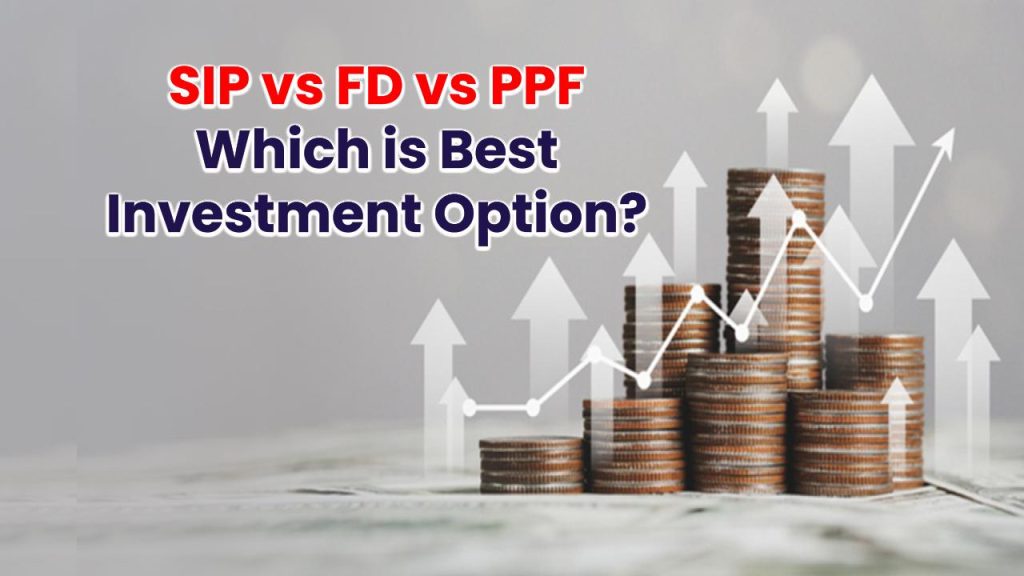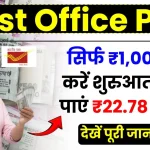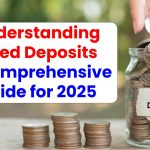
When it comes to choosing the best investment option, many people find themselves stuck between SIP (Systematic Investment Plan), FD (Fixed Deposit), and PPF (Public Provident Fund). Each of these financial tools offers distinct benefits and is tailored for different types of investors. Whether you’re a risk-averse individual, a long-term wealth builder, or someone who prefers stability and tax savings, understanding these options is crucial.
SIP vs FD vs PPF: Which is Best Investment Option?
| Features | SIP (Systematic Investment Plan) | FD (Fixed Deposit) | PPF (Public Provident Fund) |
|---|---|---|---|
| Nature | Regular investment in mutual funds | Lump-sum deposit with fixed returns | Government-backed long-term savings scheme |
| Returns | Market-linked (10-15% historically) | Fixed (2.90% – 9.05% p.a.) | Fixed (7.1% p.a. currently) |
| Risk | Moderate to High (Market-Linked) | Very Low (Guaranteed) | Very Low (Sovereign Guarantee) |
| Liquidity | High (Easy withdrawals, exit load may apply) | Moderate (Premature withdrawal penalties) | Low (Partial withdrawal after 7 years) |
| Tax Benefits | Tax benefits on ELSS SIPs under Section 80C, LTCG Tax applies | Tax-saving FDs under Section 80C, Interest taxable | Tax-free under EEE (Exempt-Exempt-Exempt) |
| Investment Horizon | Medium to Long-term | Short to Medium-term | Long-term (15 years lock-in) |
Choosing between SIP, FD, and PPF depends entirely on your financial goals, risk appetite, and investment horizon. SIPs shine for long-term wealth creation with higher returns but come with market risks. FDs offer stability and guaranteed returns but may lag in beating inflation. PPF strikes a balance with tax benefits, safety, and reasonable returns, though it requires long-term commitment.
What is SIP (Systematic Investment Plan)?
A Systematic Investment Plan (SIP) allows investors to put a fixed amount regularly (monthly/quarterly) into mutual funds. Instead of investing a lump sum, SIP encourages disciplined investing by breaking down investments into small, manageable amounts.
Benefits of SIP:
- Rupee Cost Averaging: You buy more units when prices are low and fewer when prices are high.
- Power of Compounding: Long-term SIPs can multiply wealth significantly.
- Flexibility: Easy to start, stop, or modify.
- High Returns Potential: Historically, equity SIPs have yielded 12%-15% over long periods.
Who Should Choose SIP?
- Young professionals looking for long-term wealth creation.
- Investors comfortable with market volatility.
- Those aiming to beat inflation.
SIP Example:
If you invest ₹5,000 per month for 10 years, assuming an average return of 12% p.a., you could accumulate over ₹11 lakhs. Try SIP Calculator to personalize projections.
see also: PPF or FD, Which One Will Give You More Money If You Invest for 15 Years?
What is FD (Fixed Deposit)?
Fixed Deposits (FDs) are one of the safest and most traditional investment tools. You deposit a lump sum amount for a fixed period (ranging from 7 days to 10 years) and earn a guaranteed interest rate.
Benefits of FD:
- Capital Protection: Principal and returns are assured.
- Flexible Tenure: Options from short to long-term.
- Loan Facility: Loans can be availed against FDs.
- Tax-saving FD: Offers deduction under Section 80C (with a 5-year lock-in).
Who Should Choose FD?
- Retired individuals needing safety and steady income.
- Conservative investors unwilling to take risks.
- Those with short-term financial goals.
FD Example:
Deposit ₹1 lakh for 5 years at 7% interest rate, you’ll receive around ₹1.4 lakhs at maturity. Check rates from reliable banks via RBI Portal.
What is PPF (Public Provident Fund)?
The Public Provident Fund (PPF) is a government-backed savings scheme aimed at encouraging long-term savings. It comes with a fixed interest rate (currently 7.1% p.a.) and a lock-in period of 15 years.
Benefits of PPF:
- Sovereign Guarantee: Zero risk.
- Tax-free Returns: Interest and maturity proceeds are completely tax-free.
- Loan & Withdrawal Facility: Loan from 3rd year; partial withdrawal after 7th year.
- Compound Growth: Interest compounded annually.
Who Should Choose PPF?
- Risk-averse investors.
- Salaried individuals seeking tax-saving options.
- Long-term financial planners (children’s education, retirement).
PPF Example:
Invest ₹1.5 lakhs annually for 15 years, you could build a corpus of ₹40+ lakhs, fully tax-free. Check details at India Post PPF.
SIP vs FD vs PPF: Which is Better for You?
1. For Long-term Wealth Creation:
SIP is the best option if you can withstand market ups and downs and stay invested for 5+ years. It beats inflation and has the highest return potential.
2. For Safety and Guaranteed Returns:
FD is the safest. However, returns barely beat inflation after tax.
3. For Tax Savings and Zero Risk:
PPF offers unbeatable safety, tax-free returns, and is perfect if you can lock in your money for the long term.
see also: Bank FD Big Losses: Money Will Get Stuck! Know These 3 Major Losses
Pros and Cons Table
| Investment Option | Pros | Cons |
|---|---|---|
| SIP | High returns potential, compounding benefits, flexible withdrawals | Market-linked risk, no guaranteed returns |
| FD | Guaranteed returns, low risk, flexible tenures | Taxable interest, may not beat inflation |
| PPF | Tax-free returns, government guarantee, loan/withdrawal facility | Long lock-in period (15 years), low liquidity |
SIP vs FD vs PPF FAQs
Q1. Which investment is best for beginners: SIP, FD, or PPF?
For beginners who prioritize safety, FD or PPF is ideal. If you are young and can handle some market risk, SIP offers better long-term gains.
Q2. Can I withdraw money anytime from SIP, FD, or PPF?
SIP investments can be withdrawn anytime (except ELSS SIPs with a 3-year lock-in). FDs may charge penalties for premature withdrawal. PPF allows partial withdrawal after 7 years.
Q3. Which offers better tax benefits: SIP, FD, or PPF?
PPF offers the best tax benefits as it falls under the EEE category. ELSS SIPs also provide tax deductions under Section 80C. FDs offer limited tax benefits.
Q4. Is SIP risky?
SIPs are subject to market risks. However, over the long term, they can yield high returns and balance out volatility.











